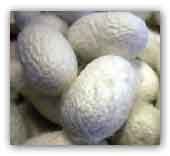|
A simple, inexpensive dip-and-dry treatment can convert ordinary silk into a fabric that kills disease-causing bacteria — even the armor-coated spores of microbes like anthrax — in minutes.

Researchers points out that in adverse conditions, bacteria of the Bacillus species, which includes anthrax, become dormant spores, enclosing themselves in a tough coating. These spores can survive heat, radiation, antibiotics and harsh environmental conditions, and some have sprung back to life after 250 million years.
Certain chemicals — most popular among which are oxidizing agents, including some chlorine compounds — can destroy bacterial spores, and they have been applied to fabrics like cotton, polyester, nylon and Kevlar.
These treated fabrics are effective against many bacteria, but less so against spores. The researchers tried a similar coating on silk to see if it could perform better against these hardy microbes.
Utilizing this facile process, unmodified silk cloth is reacted with a diluted bleach solution, rinsed with water, and dried.
Silk treated for just an hour killed essentially all of the E. coli bacteria tested on it within 10 minutes and did similarly well against spores of a close anthrax relative used as a stand-in.
The chlorination of silk was explored under basic (pH 11) and slightly acidic (pH 5) conditions. Chloramine-silk textiles prepared in acidified bleach solutions were found to have superior breaking strength and higher oxidative Cl contents than those prepared under caustic conditions.
Silk cloth chlorinated for ≥1 h at pH 5 was determined to induce >99.99996% reduction in the colony forming units of Escherichia coli, as well as Bacillus thuringiensis Al Hakam (B. anthracis simulant) spores and cells within 10 min of contact.
The processing conditions presented for silk fabric in this study are highly expeditionary, allowing for the on-site production of protein-based antimicrobial materials from a variety of agriculturally produced feed-stocks.
"Given the potent bactericidal and sporicidal activity of the chlorinated silk fabrics prepared in this study, silk-Cl materials may find use in a variety of applications," the authors say. Other applications, they add, include purifying water in humanitarian relief efforts and in filters or to mitigate the effects of toxic substances.
Other researchers developed a way to use silk to store and distribute vaccines and antibiotics without having to keep them cold. By eliminating the need for refrigeration, the technique can lower costs and help expand the use of these lifesaving medical tools around the world.
Most vaccines and antibiotics need to be refrigerated to remain effective. Their chemical structures break down when they're exposed to heat or humidity, making them less potent. These compounds are currently handled by “cold chain” distribution networks, which keep temperatures down during transport, storage and handling. The process is expensive, accounting for up to 80% of the cost of vaccines.
The cold chain system severely limits the availability of vaccines and medicines in developing nations. Billions of dollars worth of drugs and nearly half of all global vaccines are lost annually due to high temperatures and humid conditions.
A research team led by Dr. David L. Kaplan at Tufts University investigated whether silk protein could increase the shelf life of vaccines and antibiotics at higher temperatures.
Silk fibers purified from silkworm cocoons are highly resistant to changes in moisture and temperature. Previous studies have found that the fibers can form a mesh-like environment that helps to immobilize molecules and stabilize their structures.
The team developed a new silk-based film and tested it with the live measles, mumps and rubella (MMR) vaccine as well as the antibiotics penicillin and tetracycline. The MMR vaccine quickly loses potency above the recommended storage temperature of 2 to 8 °C (about 35 to 46 °F). Penicillin and tetracycline also break down quickly when unrefrigerated.
The researchers found that immobilizing the MMR vaccine in the silk film greatly enhanced its stability. Even after storage at 45 °C (113 °F) for 6 months, the vaccine retained more than 80% of its potency. Typically, the MMR vaccine would rapidly lose all its potency under those conditions.
Immobilizing antibiotics in silk greatly increased their stability, too. Tetracycline lost only 20% of its activity when stored in silk at temperatures as high as 60 °C (140 °F) for 4 weeks. These conditions would normally eliminate all its activity. Penicillin lost no detectable activity when stored in silk at 60 °C for 30 days. Typical storage of the drug under those conditions would bring a 20% loss of activity.
“We have already begun trying to broaden the impact of what we’re doing to apply to all vaccines,” says Kaplan. “This could potentially eliminate the need for the cold-chain system, greatly decreasing costs and enabling more widespread availability of these life-saving drugs.”
The study was funded by NIH’s National Institute of Biomedical Imaging and Bioengineering (NIBIB), National Eye Institute (NEI) and National Institute of Dental and Craniofacial Research (NIDCR). It appeared on July 9, 2012, in the online edition of Proceedings of the National Academy of Sciences.
For more information
American Chemical Society
http://www.nih.gov/
(MDN)
|
![]()